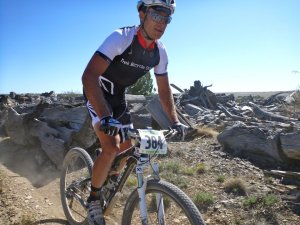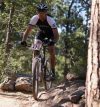 A 24 hour mountain bike race promises to test the limits of even the most experienced riders – whether you’re riding solo or as a team. A couple of weeks ago, TrainingPeaks sponsored the Boulder-based Trek Colorado Race Team as they took on the 14th annual 24 Hours of Old Pueblo race. The team dominated, taking the 1st, 2nd and 4th men’s solo spots, and 2nd place in the 4-man team relay category. In addition, Shawn Heidgen from TrainingPeaks also raced with her husband, finishing a respectable 16th place.
A 24 hour mountain bike race promises to test the limits of even the most experienced riders – whether you’re riding solo or as a team. A couple of weeks ago, TrainingPeaks sponsored the Boulder-based Trek Colorado Race Team as they took on the 14th annual 24 Hours of Old Pueblo race. The team dominated, taking the 1st, 2nd and 4th men’s solo spots, and 2nd place in the 4-man team relay category. In addition, Shawn Heidgen from TrainingPeaks also raced with her husband, finishing a respectable 16th place.
So how do you not just complete a 24-hour mountain bike race, but even get onto the podium or at least finish strong? Once these guys had caught up on their sleep and finally scrubbed the last of that Arizona dust off, we asked them to give us their best advice. Here’s what they said.
On racing 24 hours as part of a team…

Have a heart to heart with your teammates before the race starts.
Everyone needs to be on the same page about the team’s race goals. Are you here to be competitive or just for fun? What will happen to the rotation if someone is unable to continue? Who will take those critical laps in the morning that mean finishing a couple places higher? Having these discussions ahead of time is important because if in the middle of the night you may have to make a tough call.
Consistency pays off when chasing the podium.
You and your teammates should be well-matched. Knowing you can turn out lap times within a few minutes of each other is super helpful. This way you can be confident your turn is coming at 3:35 instead of some time between 3:15 and 3:45 and rest a few minutes more. It also puts the nail in the coffin of the teams chasing you when they look at your lap times and realize you won’t be giving up any time when racer #3 goes out. See the team’s lap times.
On racing 24 hours solo…

Train and race with a power meter.
It was a significant advantage having a power meter for a huge race like this. I used an SRM 2×10 power meter to help me pace. I found from previous 24-hour solos that I can sustain a level 2 power literally all day long. The first part of Old Pueblo I was quite a bit higher, so I slowly lowered my pace to stay right at my lower level 3 and upper level 2 zones. This worked well for me – the last few laps my power was still at level 2, but my heart rate was in active recovery (zone 1).
Besides pacing, the power meter helps with fueling correctly. My power meter told me I was using 800-900 kJ each hour, which requires a lot of fuel. I used Infinit Nutrition Go Far and Custom Blends, along with some solid foods like Honey Stinger Bars, and 1/4-1/2 bagel with almond butter and jelly. I’ve also had a fuel test from the Boulder Center of Sports Medicine and learned I’m a carb burner, so I used a 70-oz CamelBak that contained 6 scoops of Infinit and enough water for two laps. I used two packs and would alternate each lap. My teammate Alan would have the fresh pack ready for me every other lap. Each pack consisted of about 900 calories of fuel which lasted between 2.5 and 3 hours. So I was consuming 300 calories an hour, plus what I ate during pits. I ate about 800 cal per lap.
You may never get a fuel test like I did, but the just knowing how much energy you are expending is huge. Training and racing with a power meter will tell you what you need in a race this long.
Set goals and create a plan.
Whether your goal is to only ride during daylight hours, or do the whole race without sleep, set a goal. In addition, set lap time goals, and set the number of laps you want to complete. When setting goals, put a plan in place on how to accomplish the goals. The plan should include expected lap time, food/fuel you may want and how much, bike changes, clothes changes, adding and removing clothes as the weather changes, adding and removing lights, everything you can think of. By setting goals and creating a plan you are likely to have a great race – whatever your goal is.
On racing 24 hours as part of a duo…

Shawn Heidgen (@sheidgen) is an Education Specialist at TrainingPeaks, cycling coach, and former professional cyclist. Shawn and her husband Karl (Team Pactimo Masters) finished 16th in the co-ed duo category.
Take care of yourself and your equipment so that your teammate doesn’t have to.
Don’t make your teammate have to spend energy taking care of you when they need every kilojoule or calorie to take care of themselves. This includes planning your nutrition ahead of time and having it ready to go, and making sure your equipment (bike, helmet, shoes, lights, computer, etc) is tuned up and ready too. Bring any tools or extra parts you may need and all of your clothing options as well.
Keep your wits about you.
This is easier said than done for less experienced racers. Fortunately, both Karl [my husband] and I have years of racing to draw from and this gets us through more than you would think. For me it means always staying present, in the moment and reacting instantly and instinctively. I say instinctively because things like eating, drinking, standing, shifting, weight distribution, etc should be instinctive and automatic. If it’s not, practice and do it enough until it is. If I am stressing out or nervous (my lights died on one of my night laps and there was some brief panic) I have a conversation with myself. It goes something like this: “Relax – where’s the line? Breathe, look ahead, dig, dig, dig. You can do this.” These days neither one of us puts in the miles or training that we should for these brutal races and we hold our own just by being smart, being consistent, knowing how to take care of ourselves, and keeping our heads on straight. Lose focus for a second, get overexcited or panic when you’re fatigued and it can all be over. Experience and consistency goes a surprisingly long way against fitness and over-eagerness.
Keep it fun.
Honestly, it is a huge time, financial, physical and emotional commitment and yes, we really do have a good time racing 24 hour events. We push ourselves to the limit racing as hard as we can and we still keep it fun. The atmosphere at these races is so positive and good – let yourself be a part of it. Yeah, it’s better when you win (I am still a competitor at heart) but it’s also pretty darn fun to ride your guts out and share it with someone you love, are close to, or just share a passion with.


